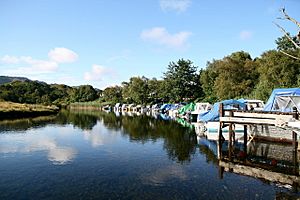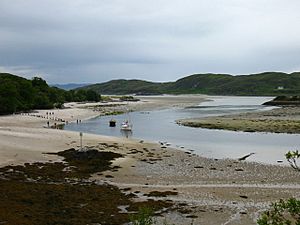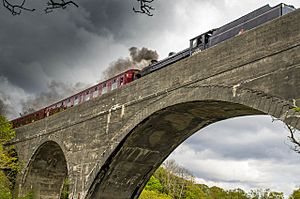River Morar facts for kids
The River Morar is a short but important river located in the beautiful west Highlands of Scotland. It starts its journey from the western end of Loch Morar, a large freshwater lake, and flows directly into Morar Bay. This bay is a part of the Sound of Sleat, which is an arm of the sea. The River Morar is quite special because it is one of the shortest rivers in Scotland, measuring less than 1 kilometer (about 0.6 miles) long when the tide is high.
The river is an important crossing point, with three different bridges built over it. One bridge carries the main A830 trunk road, which is a busy route. There's also an older bridge for the B8008 road. The third bridge is a railway viaduct, which is a type of bridge that carries a railway line. This viaduct is part of the famous West Highland Line railway. The Morar Railway Viaduct was built in 1897 and is considered a historic building, known as a Category B listed building. This means it's protected because of its special architectural or historical importance.
The River Morar also acts as a natural border. It separates two different areas, called parishes, in Scotland. To the north of the river is the parish of Glenelg, and to the south are the parishes of Arisaig and Moidart.
What Are the Falls of Morar?
As the River Morar leaves Loch Morar, it flows over a rocky area. This creates a series of beautiful waterfalls, which are known as the Falls of Morar. These falls are a natural feature that adds to the scenic beauty of the river's short path.
How Does the River Morar Help Make Electricity?
The River Morar is also used to create clean energy! In 1948, a hydroelectric power station was built on the river. This power station uses the natural flow and drop of the water to generate electricity. It has a power output of 750 kilowatts (kW) and uses a water drop, or "hydraulic head," of about 5.5 meters (about 18 feet). This means the water falls from a height to spin turbines, which then create electricity.




